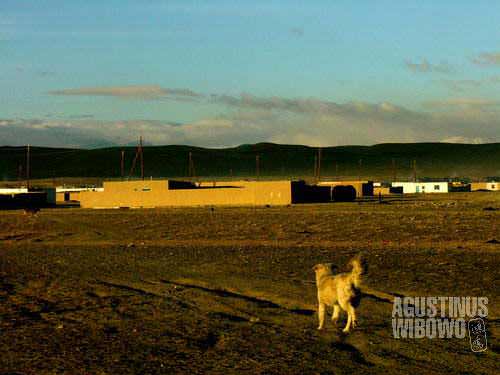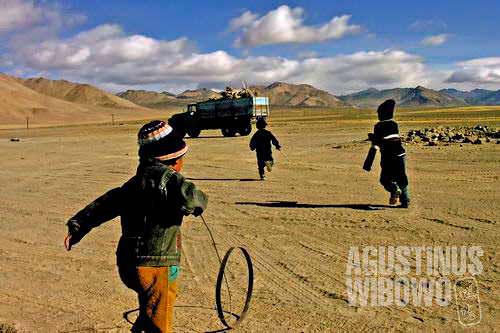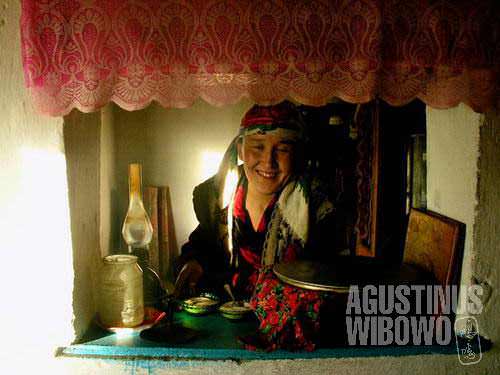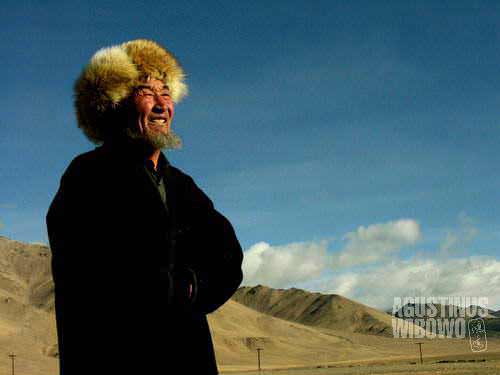Alichur – Kyrgyz Community

The steppe of Alichur
Actually I planned to stay for some more days in Langar, but I have heard that the transport onward to Murghab would be very difficult to get. This was caused by the high oil price, so people couldnt afford anymore to travel, and instead of going to smaller and hopeless Murghab they opted to bigger Khorog. Suddenly, even when I was not prepared yet, there was a passenger jeep going to Murghab on 27th. The khalifa told me if I didnt take this car, the next transport might be a month after. I had no choice but to leave Langar.
The road continued to east along the river bordering Afghanistan. Afghanistan on that side of the river had no more motorable road as it already entered the Big Pamir area. Sometimes caravans of Bactrian camels were visible along the dirt road on that side of the river, while we were travelling in a russian jeep. World differed more than a century in the two sides of the river, which was very shallow and narrow in winter. It should be very easy to cross the border illegally here. The camel caravan must be the Afghan (Pashtun) traders bringing dairy products purchased from the Kyrgyz nomads in Pamir. I regretted not being able to visit the Afghan Pamir to observe the life of the Kyrgyz there.

Those happy Kyrgyz boys of Alichur
One of the passengers in the jeep was a driver. He had an accident two weeks before, and caused death of a young child. The child’s parents were in the car also. When we passed where the accident happened, just across Afghanistan, all passengers got out and had prayers. The parents couldnt help not to cry. the tears remained in their eyes for hours after, and remained longer in their heart.
After the passport check in Khargush, the road left the Afghan border and headed to the Pamir Highway in interior GBAO. The car stopped in Alichur for dinner, at 10. I decided to stay in Alichur while other passengers continued to Murghab.
This was a small restaurant (stalovaya), packed by Kyrgyz truck drivers. The restaurant owner was a Kyrgyz lady and not speaking Tajik at all. It was dark, scary, with barks of the dogs heard every second. Eerie atmosphere indeed. I was in Tajikistan but I felt being in another country so sudden, without preparation.

Kyrgyz lady, the restaurant owner in Alichur
When all the Tajik passengers left to Murghab, I was left alone among the Kyrgyz who didnt speak any of Tajik language. My Persian words brought me no more further here. Luckily there was a Tajik man from Shegnon who was going to Murgab (Murghab) by the Kyrgyz truck and promised to bring me along until Murghab. His name is Dudkhoda.
With my broken Russian I suceeded to break the ice between me and the drivers, and even the scary restaurant lady. The ladyowner was Tajik citizen, but Dudkhoda had to speak with her in Russian. Despite of the 15 years independence from the Soviet Union, the Central Asian countries couldnt leave the shade of the Soviet times. Most interesting to know as about Naser, a 10 year old boy, son of the Kyrgyz ladyowner. He spoke Tajik, as he was taught in the school. His name is also Islamic (Arabic), common for Tajik people but not for Kyrgyz, who prefer to give Kyrgyz names derived from the nomadic history. His younger brother, Aziz, 8 years old, spoke worse Tajik. The neighbor boy, Umer, 5 years old, spoke none but Kyrgyz language, because he didnt go to school yet. I looked at Naser’s geography book. It was in Kyrgyz language. I saw some chapters about ‘our fatherland – Kyrgyzstan’, ‘our heroes’, national anthem, national flag, cosat-of-arms, and information about Kyrgyzstan cities and regions. Tajikistan respeted the Kyrgyz minority in their country as part of their Tajikistan citizens, provide them education about their language and culture. But the textbooks were simply taken from Kyrgyzstan without any alteration, made me wonder whether the Kyrgyz Tajik boys raised under this system of education would have double nationalism. Like Nasir who could sing the Kyrgyzstan national anthem, as well as the Tajik one, “zindabosh e vatan Tajikistan e azadi man….“

Kyrgyz man in Alichur, wearing the traditional furry hat and cloak, suitable for the harsh winter in the mountainous Pamir
The plain pastureland around Alichur should be very green and fertile during the summer months, and it should be perfect place for the Kyrgyz nomad to herd their cattle. The town of Alichur had many houses, all in similar block architecture, without gate, scattered around the plain. There were many big dogs, sign of nomad herdsmen community. Majority of the people here were Kyrgyz, Sunni Muslim sect followers. They had very distinctive Mongoloid physical features: small eyes, small noses, which made them very different from the Tajiks. Nasir, in my eyes, looked more like a Chinese boy.
Jehangir, 22, one of the Kyrgyz drivers from Osh taught me little bit Kyrgyz language,. The grammar seemed not that difficult, but I barely knew any vocabulary and my Russian limitation didnt allow me to go further. But now I could imitate the little boys saying: “Ata mekenim…, Kyrgyzstan!!! (My father land is Kyrgyzstan!)”






Leave a comment